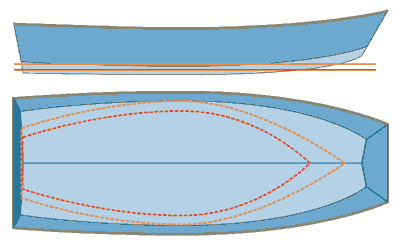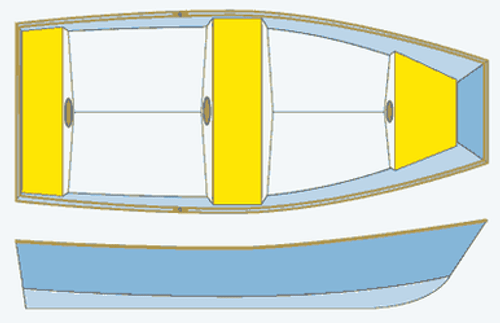The 14ft Nuthatch Pram
Thank you for choosing to build the 14 foot Nuthatch Pram. After designing and building the 8ft Nuthatch Pram and designing the 12ft Nuthatch Pram, I thought that a larger version of the hull would be a good fit in my series of stitch and glue boats. This is the finished design of the14ft "fishing" version. I had this design finished in May of 2008, but it wasn't until a person in Denmark asked Chuck this year if I had a 14ft version of the Nuthatch Pram that I looked at it again. I printed out the last design to see what needed to be finished on the lines of the hull. Nothing, and the cardboard model now hangs in my kitchen.

The main change in the10ft, 12ft, and this larger 14ft version of the Nuthatch Pram from the original 8ft hull, is the use of a curved arc along the bottom edge of the two side panels. On the 8ft hull, the bottom edge to the two side panels is a straight line. This was used to help in the lofting and construction process. The straight edge on the 8ft hull, also kept more hull below the waterline near the stern in this shorter version. Which in turn increased it's load carrying capacity, and increased it's stability. The larger hulls, from 10ft and up, have extra width and length to offset the need to keep the straight line on the chine seam. Plus the curve added to this and the other larger hulls, just makes the designs look better; with the smooth flowing (not quite parallel) curves of the chine and shear lines of the side panels. The curve in the side panels at the stern, also picks and lifts up the aft outside ends of the two bottom panels, and reduces the wetted area to improve rowing (if you do on this longer hull) when solo in the boat.
This hull design is mainly for those that wanted a fishing style hull, and needed a different seating layout than what is normally shown in my designs. I have moved the rear seat off the stern so you may control your outboard motor more easily, and have storage for the fuel tank between the seat and transom; if you use a fuel system that feeds the motor directly. As with all my previous prototype hulls, I will add the sailing option to the design; but not at this time. Check the John Duk study plans to see other interiors.
I have gone to using the "enclosed pyramid" (with watertight hatches) style of seating in all my designs for safety reasons. After reading a story with photos, dealing with the deep water self rescue of a brand new "traditional open interiorâ small boat design, and they couldn't empty out the water; I will no longer include drawings or instructions for old style wooden plank seat interiors. Your safety, and that of your family members is more important to me, than any negative comments about my hull interiors. This hull as designed, has around 10+ cubic feet of extra positive flotation build into the enclosed pyramid seating. That's over 600 pounds of extra support, along with the wood in the hull; and you will have less water to bail out. The two handles or steps on the stern are there to help you or a loved one, get back in the boat again if needed. Always carry and wear, a life jacket adequately sized for you and your guests, and be sure they are in good condition at all times.
I have not built a prototype hull to test the lofting, but after tank testing the previously built 10ft Nuthatch Pram, and comparing that with it's launch photos; the 10ft Nuthatch Pram sat better than I though it would, and so this 14ft version should too. I kept adding "people" to the 14ft model and it hardly moved. I have also found that there are very few "tweaks" that I have had to make to any prototype design while building. They have been in the 1/16" +/- range at a couple points during the lofting and curve smoothing stage, and usually dealing with the curved "arc lengths" between the mating edges of the side and bottom panels. I would expect no major problems for you during the construction of this boat.
Thank you again.
Warren D. Messer
Red Barn Boats
SPECIFICATIONS:
LOA: 14' 5"
SPECIFICATIONS:
LOA: 14' 5"
LWL: 11' 4"
Beam: 66"
Weight: Depending on the wood used!
Okoume: 220-250lb
Meranti/Keruing 250-360lbs
Maximum Outboard: 35hp
U.S.C.G. Calculations for a Tiller controlled OB are higher, but 35hp is all
that should be used with this hull. I would stop at 15hp!
A "long shaft" motor is also needed because of the depth of the transom panel!
Maximum Load: 850lbs
Maximum Persons: 4@190lb/each








